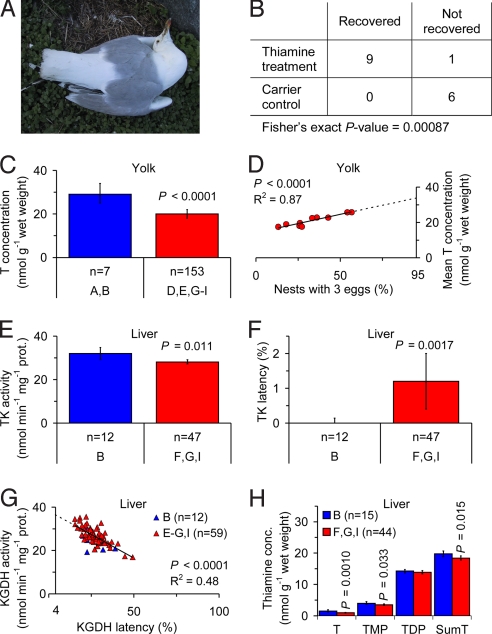Fig. 2.
Observations of thiamine deficiency in the herring gull (Larus argentatus). (A) A specimen in the County of Stockholm (region F in Fig. 1) suffering from opisthotonus and difficulty in keeping the wings folded along the side of the body. The specimen is dying while incubating, an abnormal situation. (B) Thiamine treatment of paralyzed full-grown specimens from the Baltic Sea area had a highly significant effect on recovery. (C) Yolk T concentration was 34% lower in the Baltic Sea area (regions D, E, and G–I in Fig. 1) than in Iceland (regions A and B in Fig. 1). (D) Relationship between mean yolk T concentration in the first laid eggs and proportion of nests with 3 eggs in 10 colonies in the Baltic Sea area. Extrapolation to 95% nests with 3 eggs yielded a yolk T concentration of 34 nmol/g wet weight. (E) Liver TK activity in pulli was 12% lower in the Swedish coastal regions together (regions F, G, and I in Fig. 1) than in Iceland (region B in Fig. 1). (F) Liver TK latency (i.e., the proportion of apoenzyme) in pulli was significantly higher in the Swedish coastal regions together (regions F, G, and I in Fig. 1) than in Iceland (region B in Fig. 1). (G) Relationship between liver KGDH activity and latency in pulli. Extrapolation to 4.0% latency, assumed to be normal in healthy individuals, yielded an activity of 36.5 nmol/min per mg protein. (H) Liver thiamine concentrations in pulli. T, TMP, and T+TMP+TDP (SumT) concentrations were 34%, 13%, and 7% lower, respectively, in the Swedish coastal regions together (regions F, G, and I in Fig. 1) than in Iceland (region B in Fig. 1). Error bars (C, E, F, and H) indicate 95% confidence intervals of the mean. P-values are given only when significant. n = number of clutches. Blue, Iceland and red, Baltic Sea area.

